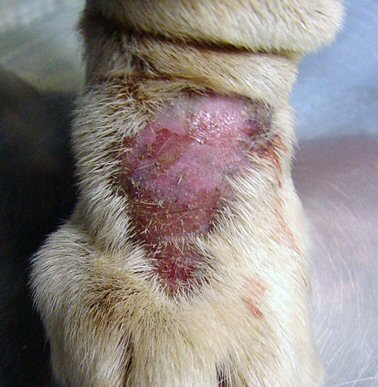Hot Spots & Wet Eczema are the same thing. Dermatitis is “doctor-speak”. If you break down the parts of the word you get derm which means skin and itis which means inflammation therefore if you or your dog are suffering from dermatitis, it simply means inflammation of the skin. In dogs, it can be caused by anything that irritates the skin but the most common causes are:-
topical skin allergies,
food related skin allergies,
skin infections,
skin fold problems,
skin parasites like the flea, mite, lice or fly strike.
Patches of wet eczema, also known as a “hot spots,” or “moist eczema”, are usually a recurring condition in dogs. They occur where a dog licks and scratches too much. When the skin itches, the dog scratches or licks it. This in turn makes the skin sore and inflammed which is uncomfortable and itchy so the itch/scratch cycle is perpetuated. This causes the formation of a wet scab on the skin under the fur. The dermatitis can be confined to a very small area or alternatively you may find that it affects the entire surface of the skin. Because of the sparse hair covering on the underside of the abdomen, this is often the easiest place to notice wet eczema but hair that appears moist and lifted up is likely to be lying over the top of a hot spot.

Wet eczema can very often be treated successfully at home without the need to see a vet. However, if the condition is a very serious case, the treatment you are giving is not working well or perhaps the condition keeps recurring, it is best to have your vet give his opinion as to the best treatment as soon as possible.
Treatment
Sometimes anti-inflammatory treatments in the form of creams, tablets or injections may be given to ease the intense discomfort and a common remedy for this condition is cortisone because it minimises the itching.
1. Firstly, expose the affected region to the air by trimming the fur away from the area around the wet eczema. If the area is large, you will need to gently shave off the fur and expose the wet eczema patch. Exposing to the air should help enable the wet eczema to dry (as its name implies, “wet” eczema may be weeping or oozing) and scab over to speed up the healing time.
2. Use an antiseptic spray or gentle shampoo on the infected area. Make sure whatever product you use is gentle on the skin. When using the shampoo, be very gentle when you work it into a lather and thoroughly clean the area. Pat the surface dry carefully and avoid any abrasive rubbing of the area. Once the affected surface is clean and dry, apply hydrocortisone cream, which will help the wound to heal and minimise the itching.
3. In order to allow the area a realistic chance of healing, you must break the itch/scratch cycle so it is important to prevent further licking or scratching of the hot spot. It may be necessary to fit your dog with Elizabethan or Buster type collar for any times when you are unable to supervise their activities and ensure they leave it alone. It is also a good idea to ensure your dogs nails are trimmed neatly to minimise the amount of damage they may do in scratching.
4. If you feel that the affected area is not healing or is perhaps getting worse or even spreading, it is important to visit your vet for professional advice and treatment, possibly including tablets, a topical lotion to be applied directly to the skin surface or even an injection of cortisone. It is important to follow your vet’s instructions to the letter when treating cases of dermatitis to ensure that this very uncomfortable condition clears up as quickly as possible.
